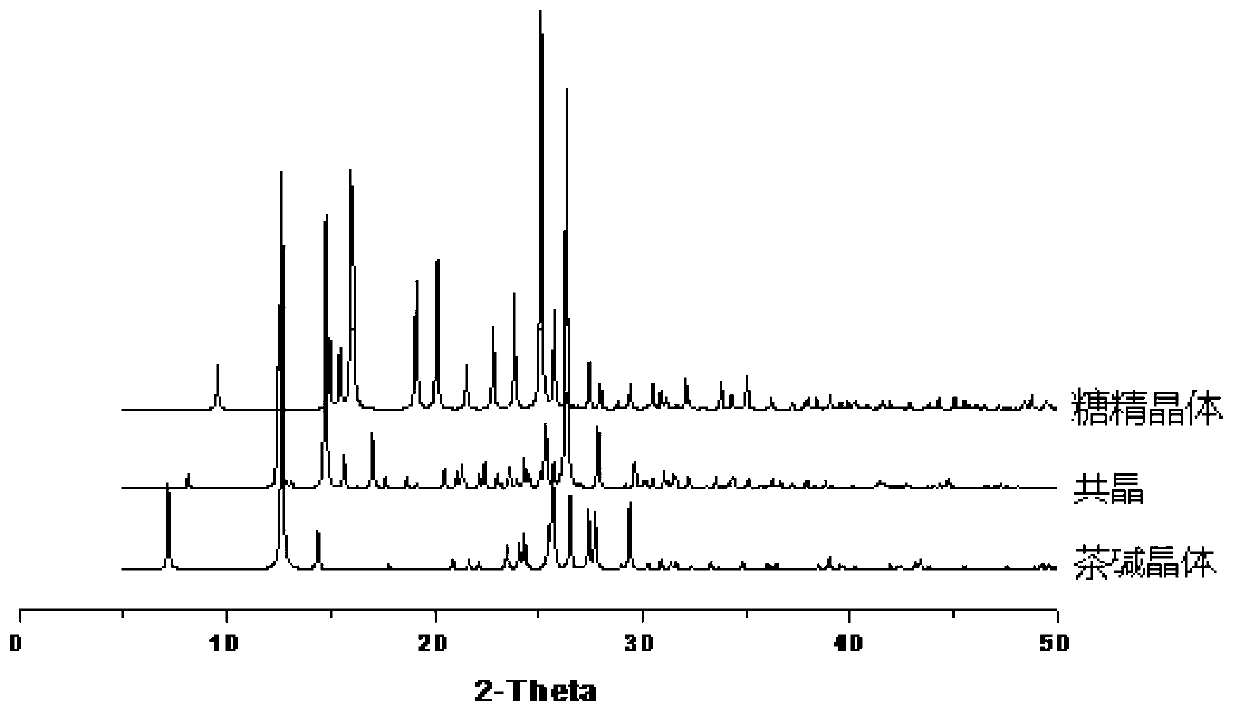Method for directionally preparing theophylline-saccharin eutectic through membrane technology
A membrane technology, theophylline technology, applied in the field of preparation of theophylline-saccharin co-crystal, can solve the problem of not being able to obtain pure co-crystal
- Summary
- Abstract
- Description
- Claims
- Application Information
AI Technical Summary
Problems solved by technology
Method used
Image
Examples
Embodiment 1
[0017] (1) Add 50ml of fresh Piranha solution into a large beaker, put the cut glass piece (20X20mm) into it, heat at a constant temperature of 70°C for 120 minutes, take out the glass piece, and wash with deionized water, isopropyl Wash carefully with alcohol, absolute ethanol and n-hexane, and dry to obtain hydroxylated glass flakes. Put the hydroxylated glass flakes into 60mL of 10mM aqueous solution containing 3-chloropropyltrimethoxysilane at room temperature, airtight Place it under the same conditions for 100 minutes to obtain a silanized glass sheet; wash the silanized glass sheet with fresh n-hexane, put it in anhydrous methanol for 10 minutes; wash it with anhydrous methanol, and dry it at 50°C 12h, a silane monomolecular self-assembled film was obtained on the surface of the glass sheet;
[0018] (2) Add 3.0g of theophylline and saccharin with a molar ratio of 1:1 into a container containing 100mL of methanol, heat to 50°C to dissolve all the solids; cool to 25°C, p...
Embodiment 2
[0021] (1) Add 50ml of fresh Piranha solution into a large beaker, put the cut glass piece (20X20mm) into it, heat at a constant temperature of 90°C for 90 minutes, take out the glass piece, and wash with deionized water, isopropyl Wash carefully with alcohol, absolute ethanol and n-hexane, and dry to obtain hydroxylated glass flakes. Put the hydroxylated glass flakes into 60mL of 15mM aqueous solution containing 3-aminopropyltrimethoxysilane at room temperature, airtight Place it under the same conditions for 150 minutes to obtain a silanized glass sheet; wash the silanized glass sheet with fresh n-hexane, put it in anhydrous methanol for 5 minutes; wash it with anhydrous methanol, and dry it at 80°C 8h, a silane monomolecular self-assembled film was obtained on the surface of the glass sheet;
[0022] (2) Add 4.0g of theophylline and saccharin with a molar ratio of 1:3 into a container containing 100mL of ethanol, heat to 50°C to dissolve all the solids; cool to 30°C, put T...
Embodiment 3
[0025] (1) Add 50ml of fresh Piranha solution into a large beaker, put the cut glass piece (20X20mm) into it, heat at a constant temperature of 80°C for 100 minutes, take out the glass piece, and wash with deionized water, isopropyl Wash carefully with alcohol, absolute ethanol and n-hexane, and dry to obtain hydroxylated glass flakes. Put the hydroxylated glass flakes into 60mL aqueous solution containing n-propyltrimethoxysilane with a concentration of 20mM at room temperature and under airtight conditions. Place it for 150 minutes to obtain a silanized glass sheet; wash the silanized glass sheet with fresh n-hexane, put it into anhydrous methanol for 20 minutes; wash it with anhydrous methanol, and dry it at 70°C for 10 hours. A silane monomolecular self-assembled film was obtained on the surface of the glass sheet;
[0026] (2) Add 5.0g of theophylline and saccharin with a molar ratio of 1:5 into a container containing 100mL of ethanol, heat to 50°C to dissolve all the sol...
PUM
 Login to View More
Login to View More Abstract
Description
Claims
Application Information
 Login to View More
Login to View More - R&D
- Intellectual Property
- Life Sciences
- Materials
- Tech Scout
- Unparalleled Data Quality
- Higher Quality Content
- 60% Fewer Hallucinations
Browse by: Latest US Patents, China's latest patents, Technical Efficacy Thesaurus, Application Domain, Technology Topic, Popular Technical Reports.
© 2025 PatSnap. All rights reserved.Legal|Privacy policy|Modern Slavery Act Transparency Statement|Sitemap|About US| Contact US: help@patsnap.com

